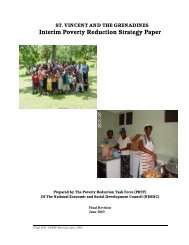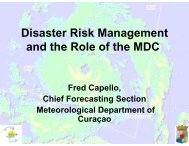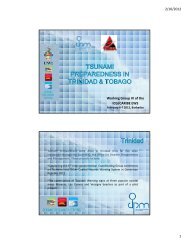The Anatomy of A Silent Crisis The Anatomy of A Silent Crisis
The Anatomy of A Silent Crisis The Anatomy of A Silent Crisis
The Anatomy of A Silent Crisis The Anatomy of A Silent Crisis
- TAGS
- anatomy
- www.bb.undp.org
You also want an ePaper? Increase the reach of your titles
YUMPU automatically turns print PDFs into web optimized ePapers that Google loves.
68 Forum 2009: Climate Change – <strong>The</strong> <strong>Anatomy</strong> <strong>of</strong> a <strong>Silent</strong> <strong>Crisis</strong><br />
Figure 13 — Threats to Millennium Development Goals due to climate change<br />
MDGs Threat to MDGs<br />
Goal 1: Eradicate<br />
extreme hunger<br />
and poverty<br />
Goal 2: Achieve<br />
universal primary<br />
education<br />
Goal 3: Promote<br />
gender equality<br />
Goals 4, 5, and<br />
6: Reduce child<br />
mortality, improve<br />
maternal health<br />
and combat HIV/<br />
AIDS, malaria and<br />
other diseases<br />
Goal 7: Ensure<br />
environmental<br />
sustainability<br />
Goal 8: Develop a<br />
global partnership<br />
for development<br />
• More frequent and intense weather-related disasters threaten<br />
livelihoods, regional food security is undermined and vulnerability <strong>of</strong><br />
poor people increases<br />
• Water scarcity further aggravates the problem as vase amount <strong>of</strong> fresh<br />
water is required to half hunger.<br />
• Without the effects <strong>of</strong> climate change, about 10 million fewer people would<br />
live in poverty today.<br />
• <strong>The</strong> number <strong>of</strong> malnourished is expected to increase due to climate change.<br />
• Loss <strong>of</strong> livelihoods means more children will be engaged in incomeearning<br />
activities and the displacement and migration <strong>of</strong> families will make<br />
education a low priority.<br />
• Infrastructure, such as schools are destroyed. For example, in 1998,<br />
Hurricane Mitch destroyed one-quarter <strong>of</strong> all <strong>of</strong> Honduras’ schools.<br />
• Women make up two-thirds <strong>of</strong> world’s poor and are more adversely<br />
impacted by disasters.<br />
• Additional burdens are placed on women’s health as additional work and<br />
chores increase stress levels<br />
• Women and children are particularly vulnerable to extreme weather events.<br />
For example, 90 percent <strong>of</strong> victims in the cyclone in Bangladesh in 1991<br />
were women and children.<br />
• Children and pregnant women are particularly susceptible to vectorand<br />
water-borne diseases, malnutrition and diarrhoea, all <strong>of</strong> which<br />
are expected to grow due to climate change. About 90 percent <strong>of</strong> the<br />
deaths occur in children under 5.<br />
• Climate change causes fundamental alterations in ecosystems, such as<br />
losses <strong>of</strong> coral reefs, for example<br />
• Climate change has reduced biodiversity. IPCC estimates that 20-30<br />
percent <strong>of</strong> global species are likely to be at risk <strong>of</strong> extinction this century.<br />
• Climate change changes the quality and quantity <strong>of</strong> natural resources. For<br />
example, 20 million people in six countries in West and Central Africa rely<br />
on Lake Chad for water, but the lake has shrunk by 95 percent in the last<br />
38 years.<br />
• Investment in adaptation and mitigation is crucial and requires close<br />
cooperation and coordination.<br />
• <strong>The</strong> lack <strong>of</strong> adequate investment for adaptation acts as a significant drag<br />
on humanitarian assistance and development.







